Opinion & Analysis
TourPutt – The secret of the pros?
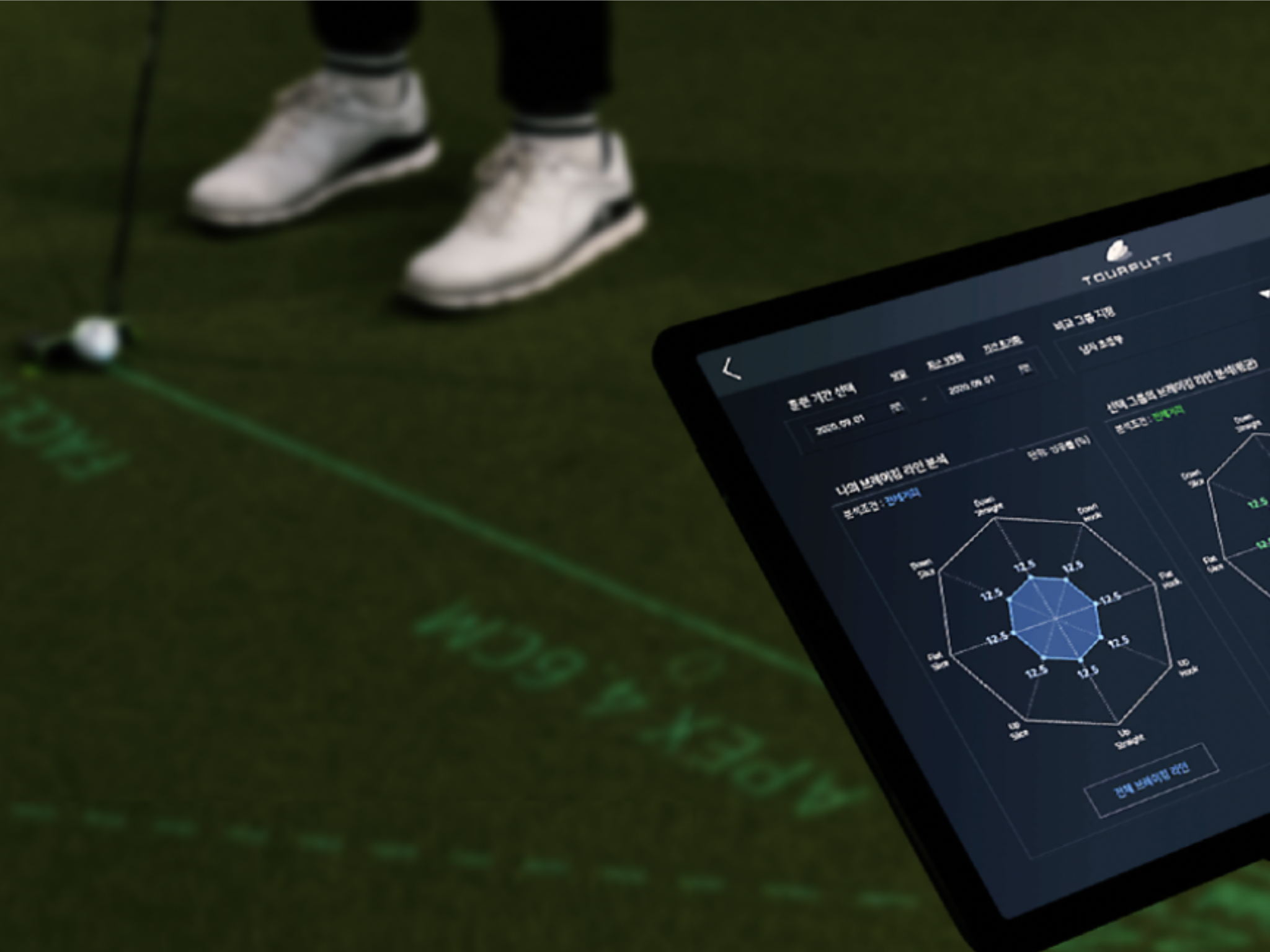
Driver vs. Putter: Your Choice?
If you were granted one golf-related superpower, which would you choose? The ability to hit 300-yard drives straight down the fairway all the time, or never 3-putt again?
Bobby Locke, one of the greatest putters in the game, said to ‘drive for show, but putt for dough’ And when you consider that the putter is the most used club in the bag, it seems like a no-brainer. But then again, according to Mark Brodie and his ‘strokes gained’ method, a long, straight driver may be more important to saving strokes. So what would you choose?
For me, I wouldn’t hesitate to go with the putting skills as I am currently suffering from the worst case of yips I’ve ever experienced in over 30 years. Sure, it’d be nice to outdrive the guys in my regular foursome, but I don’t think I can live down the shame of missing inside of 3ft all day, every day. And with no genie in site, I have searched high and low for that perfect putter that can cure my woes.
After trying nearly 50 putters over the past two years and enduring numerous snide remarks to get putting lessons instead, I finally gave in. I bit the bullet and sought professional help from Jong-hwan Choi, Korea’s number one putting coach to the pros.
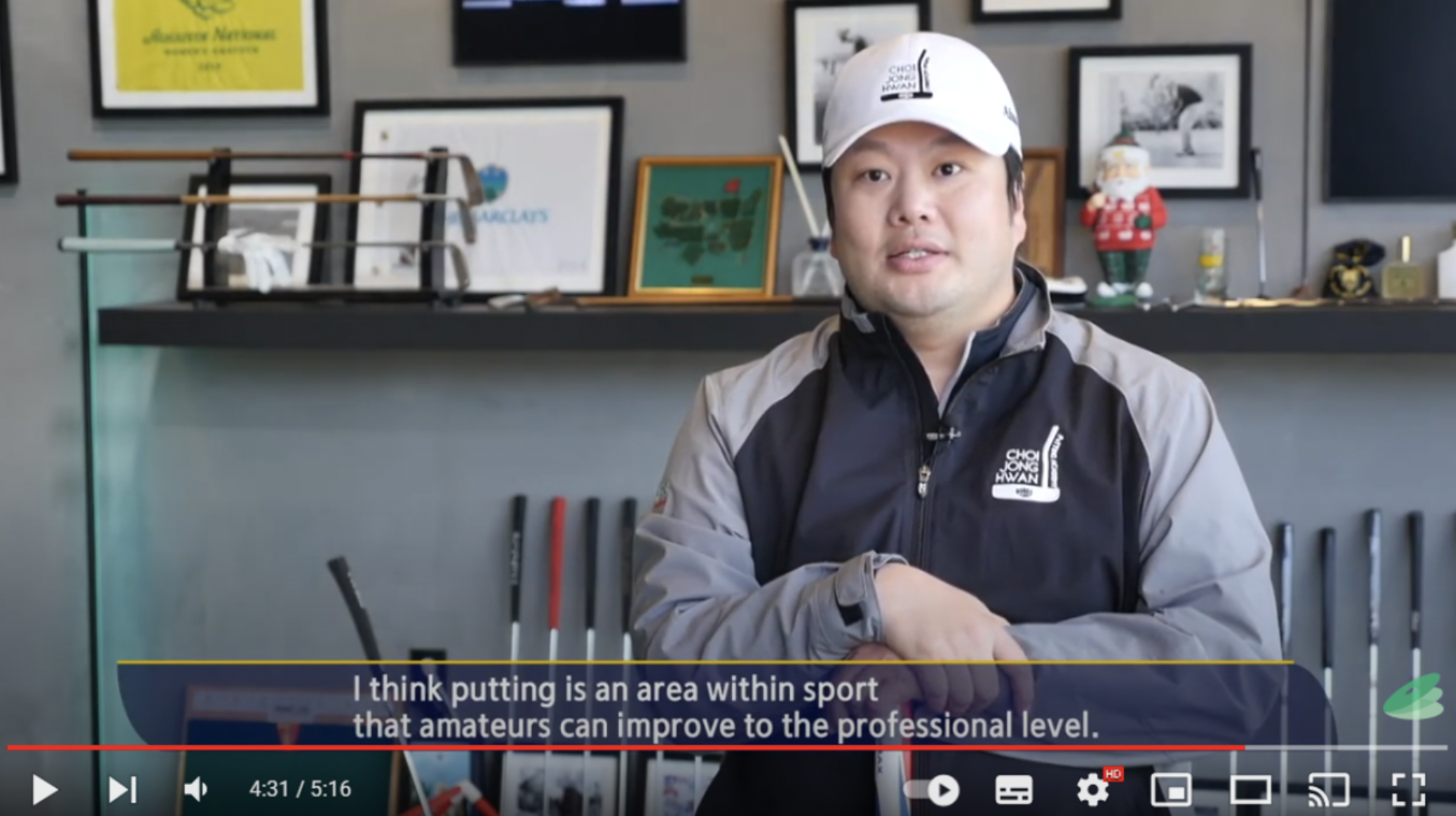
Choi’s resume includes LynnBlake Master Instructor certification, AimPoint LV3, PuttDoctor, MichaelHebron Neuro Learning for Golf, and many others.
Choi is an accomplished Tour putting coach who has made a name for himself through relentless research and dedication to master his chosen craft. Thus far, the pros and elite amateurs he helped have won a total of 350 tournaments, including KPGA, KLPGA, and LPGA wins. He is so popular that it can take up to a year to book a lesson with the man himself, but I was desperate. After pulling all the strings I can muster, I was able to get an interview with him in the hopes of getting some help
with my flat stick.
When the day finally came, I arrived at Choi’s academy armed with 3 of my current best-performing putters. I was eager to glean the secrets of the pros and to find out which of these best fit my stroke. I was greeted by Choi and briefly shown around the spacious academy, which had a large flat putting surface and some basic training aids that are common online. Upon chatting about Choi’s background and teaching philosophy, he reminded me of the motivational speaker Tony Robbins. He was constantly emphasizing positivity and proactive learning reinforced with hard work and dedication towards self-growth – that skills are built, not born. Sure, I get that.
But surely, preaching alone doesn’t improve (my) putting?
TourPutt: The Secret of the Pros?
When Choi offered (after some subtle arm twisting) to look at my putting, I was puzzled when he pulled out a tablet rather than some kind of putting trainer. I figured maybe he was going to film me first, then point out some flaws on the monitor. Nope.
We were going high-tech for this one. We were joined by his friend and business partner Chan-ki Kim, a software engineer who co-developed TourPutt, a state-of-the-art putting training system.
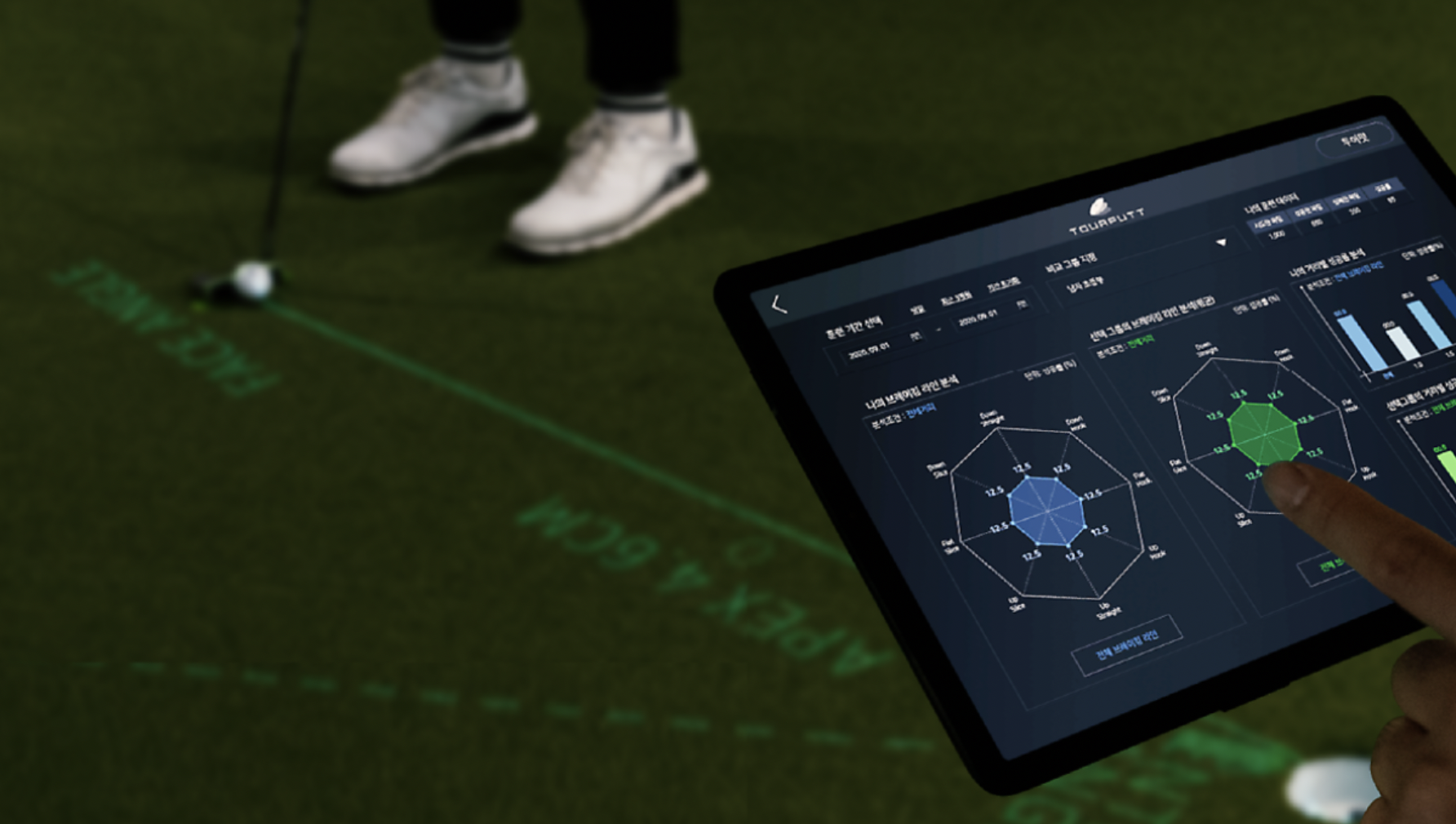
According to the dynamic duo, TourPutt was developed to accurately assess a player’s putting tendencies, habits, and skills utilizing big data and A.I. Rather than second-guessing and trying to identify the faults, Tour Putt acts like an MRI machine that shows the doctor where to problem lies. Once the diagnosis is made, Choi would bring to bear his extensive experiences to cure the ailing putter. Sounded simple to me. But how would it know what my problem was?
As Choi’s fingers danced over the tablet in his hand, the TourPutt sprang into action and a small circle the size of a hole-cup appeared on the artificial putting surface. As I surveyed the circle of light beamed from a ceiling projector, Choi asked me a question I hadn’t considered before. ‘Which breaks are you most comfortable with on short putts? What are the odds that you make them?’ Taking my blank look as his cue, Choi proceeded to explain the process of mapping my putting pattern to gauge my stren gths and weaknesses.
To begin, I was directed to putt a golf ball into a hole from 36 random locations ranging from 3 to 6 ft. A ball tracking camera with two projectors mounted on the ceiling rendered various crisp, clear images onto the putting surface. Prior to start, I was informed that the putting surface was sloped 3% from top to bottom. So if you were to imagine a clock face, the 12 o’clock location would be a 3° downhill straight putt, while 6 o’clock would be a 3° uphill straight putt.
As I am right-handed, all putts from the left side of the 3 o’clock would be a hook like, and the left side a slice lie, all to varying degrees. When I asked why it was fixed at 3%, Kim explained that tour regulation greens don’t allow for more than a 3 degree slope within 6ft of the hole. Also, most amateur golfers had a difficult time detecting such a small amount of slope, and thereby misjudge the breaks to a higher score.
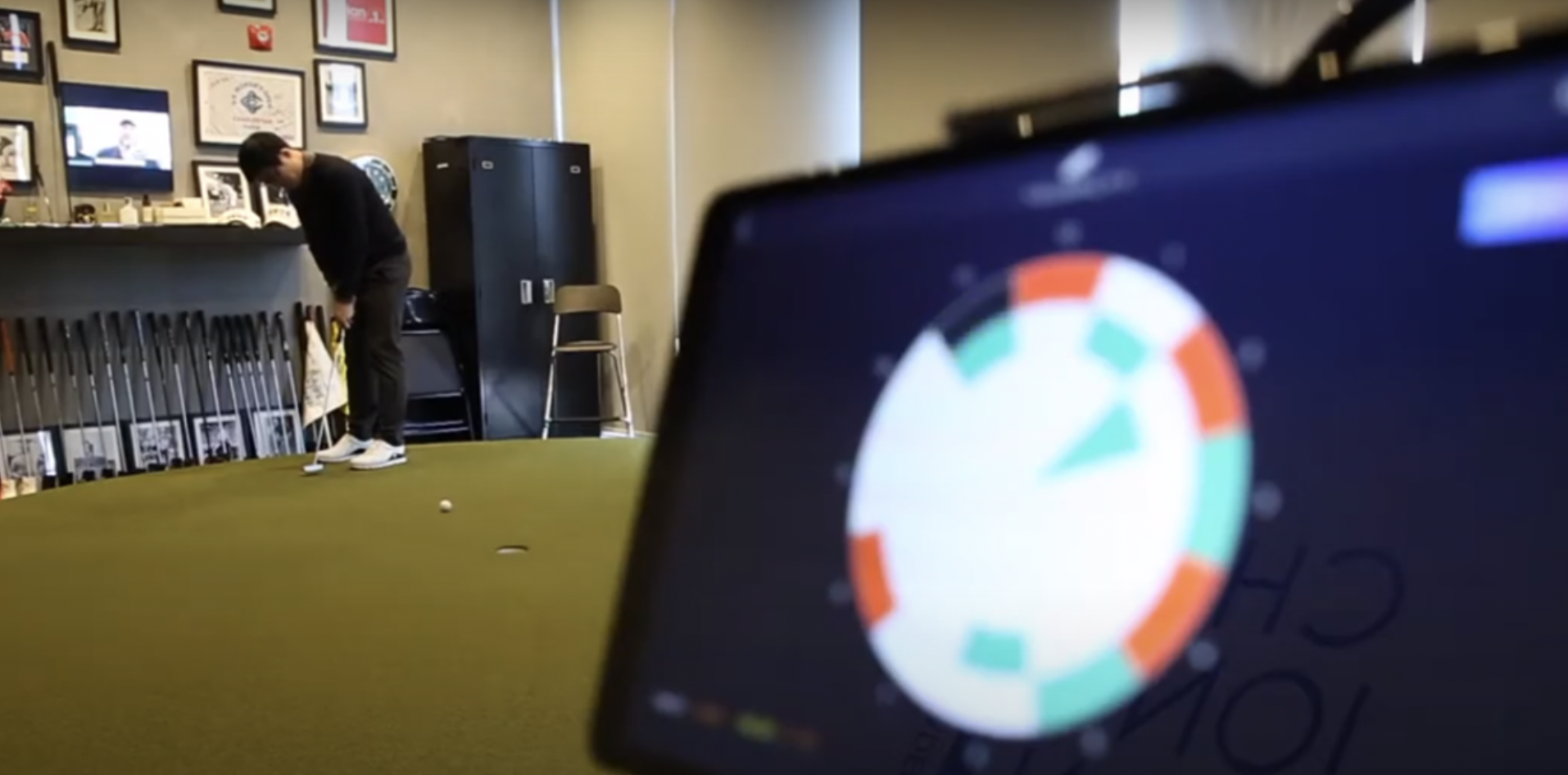
Knowing Where to Tap
After the pattern test began, it took me a little over 20 minutes to complete a total of 36 putts at random locations. I was quite conscious of the many eyes on my performance and equally frustrated at how often I was missing putts despite my best efforts. After I was done, Choi pulled up my results, or key performing index (KPI), on a large screen TV where I was able to see exactly where I was effective in my short putts. In brief, I had a tough time with both hook and slice lie putts. I showed slightly better results with uphill straight and slice putts, but absolutely nothing to write home about.
Now, I’m sure many of you are familiar with the story of the plumber who was called to fix a steam pipe. After looking around the pipes and tapping a couple of valves, he charged $200 for his services. When the irate customer demanded to know why it cost so much and asked for a detailed breakdown of the services, the plumber replied, ‘$10 for tapping, $190 for knowing precisely where to tap.’
As such, my results from the pattern test were eye-opening. I’ve never known what lie I was more effective at, much less the percentage of probable success. For example, the more often I use TourPutt to practice or diagnose my putting, the more accurately it can diagnose my skills. Thus, I can pinpoint which area to improve through practice, as well as try to get the ball to an area I am more likely to save par.
Wow. This was tour pro stuff. Was this the secret of the pros?
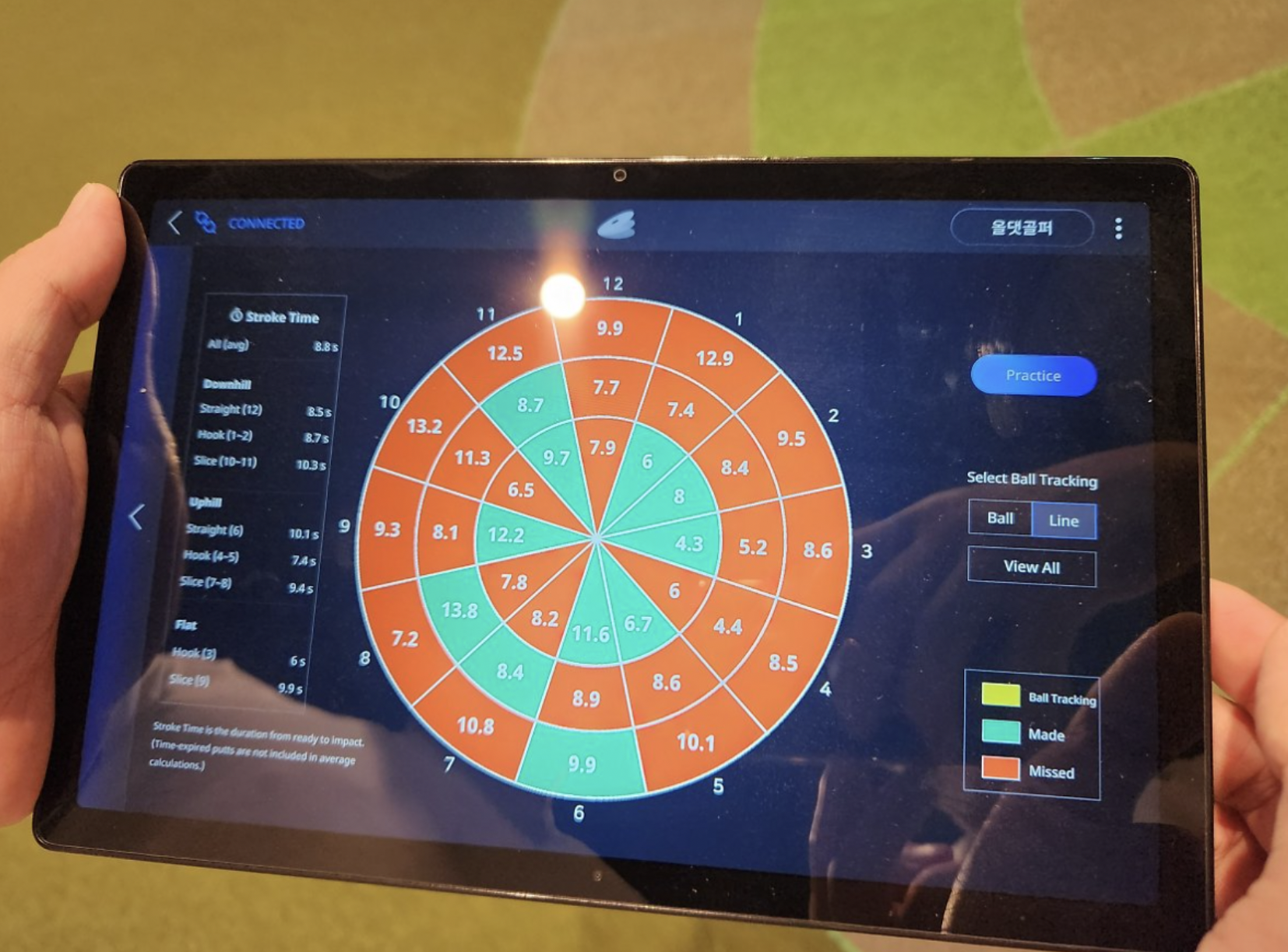
The green area indicates a successful putt and the red is where I missed. The numbers show how long it took me to strike the putt after being instructed by a bell sound.
I was starting to get heady with the possibilities this digital marvel was able to provide. It took both of them to bring me down to earth again by informing me that knowing the areas of improvement is only half the battle.
For the actual tapping part, Choi and Kim then walked me through the many innovative features of TourPutt focused on helping me improve my putting. I was mesmerized by the detailed graphics that flashed all over the putting surface.
I was already impressed with the diagnostic aspects of TourPutt, but upon seeing the actual features to help me improve my putting, I was doubly blown away. From reading the green speed and breaks accurately to effective swing tempo and motion tracking, the system seemed straight out of the future.
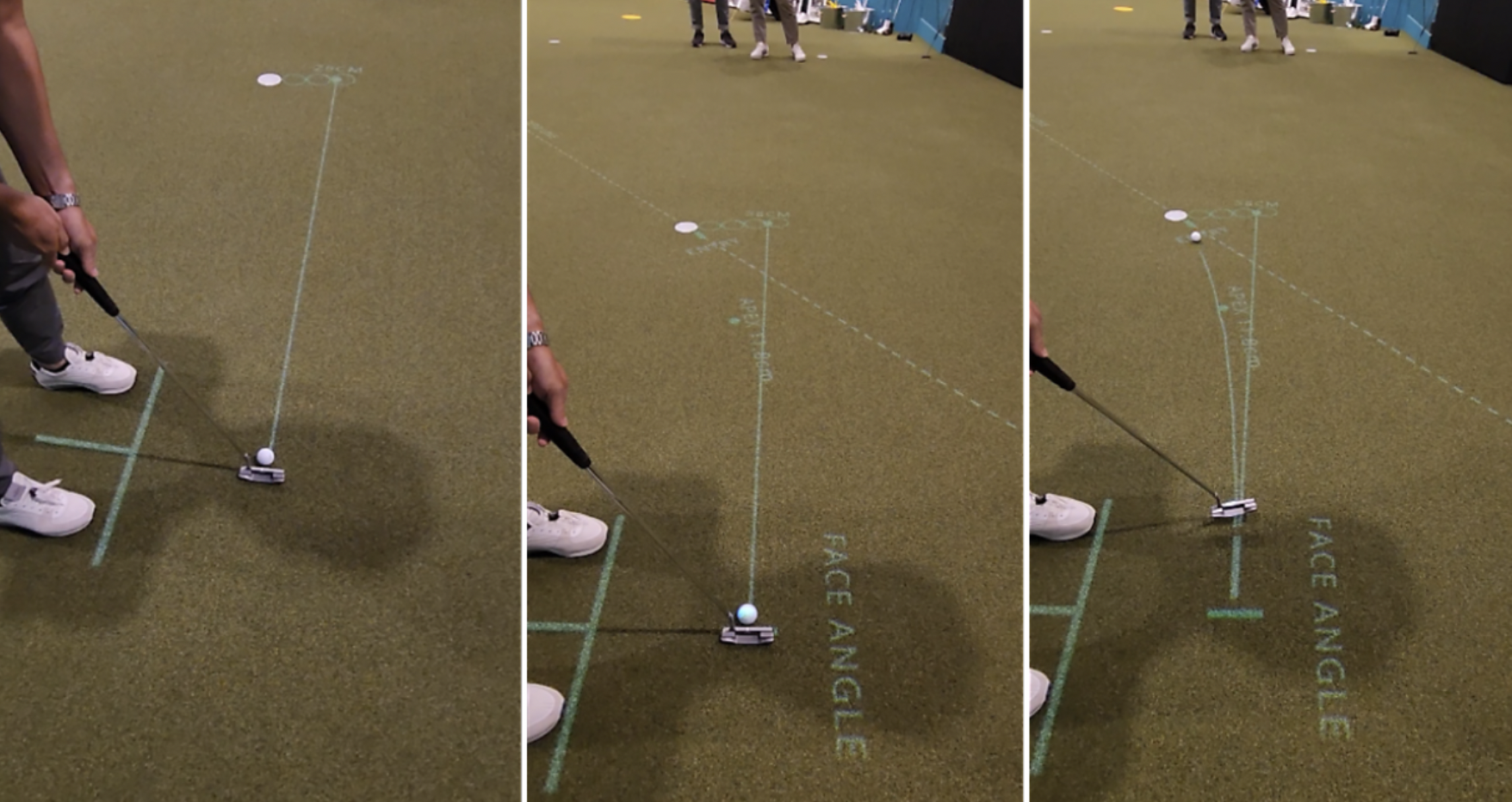
Putting from variations of the 3% slope helps golfers to get a better feel the greens, a skill that can translate onto reading the breaks on actual greens.
Before TourPutt came into being, Choi was frustrated with the difficulty in collecting crucial data from an actual green as it was difficult to find a flat area to map his student’s patterns. When he discussed the matter with Kim back in 2019, Kim immediately became interested in ways to mesh modern technology and A.I. driven data to the art of putting. As an elite level golfer with extensive knowledge in the fields of VR and AR (virtual and augmented reality), Kim understood right away the issues faced by Choi and how he could help.
Delving deep into Choi’s experience and insights, Kim designed the TourPutt’s interface to yield accurate and reliable data that can be cross-checked, correlated, and compared across past and future performances. Best of all, TourPutt and its proprietary app feature the ability to keep track of all of my performance from any TourPutt system and access the data anywhere at any time. I could even replay all of my past putts and see the speed and the path it took, and compare them with other golfer’s data in the system. Mind. Blown.
Kim further explained that this feature of collecting real-world significant big data is one of the biggest advantages of TourPutt, and enables it to evolve further with every putt stored in its vast database.

The app can be used in both English and Korean, and can keep track of my performance and improvements.
The Student Becomes The Teacher
Once the flaws are identified, we moved on to the more traditional slow-motion video to see what I was doing wrong to miss the putts. For me, I kept too much weight on the back foot, and also needed more forward press to keep the putter head online through impact.
After several minutes of drill to correct the issues, I was holing the putts much better. The data from the second pattern test confirmed the improvement, and I was also shown the actual paths that my two putts took before and after the fix. All in all, being able to verify that the diagnosis was correct with immediate results, all backed by data was highly reassuring and enlightening. But what if these improvements were short-lived? That as soon as I walk out of Choi's presence, the magic evaporates and my crappy putting returns? I can’t tell you how often a club I thought was the answer to my prayers devolved into an ordinary stick as soon as I paid for it. It’s downright uncanny how often this happens.
To this end, Choi gave me a glimpse of hope. He assured me that since I was investing time into my skills and not money into more equipment, it will definitely last longer. Also, the coaching provided by Choi is reflected in each and every putt I had made since the lesson and recorded as part of my putting profile. So if I were to stray from the ‘good’ putts, the system can be used to bring me back on track. And if this cycle of improvement continues, I would be able to be my own teacher and
eventually practice effectively and independently on my own.
Honestly, I don’t know about this part. After all, I too know that the right diet and exercise will give me a six-pack; but knowing and doing it are two separate things. In the end, how effective any tool can depend on how well I make use of it, so it will have to remain to be seen. What I can say with certainty, however, is that TourPutt seems to work for a lot of people. Choi’s students continue to post wins on various tours with regularity, each crediting him with their improved putting performance. In turn, Choi credits his partner Kim and TourPutt’s growing database for accurate diagnosis and self-learning.
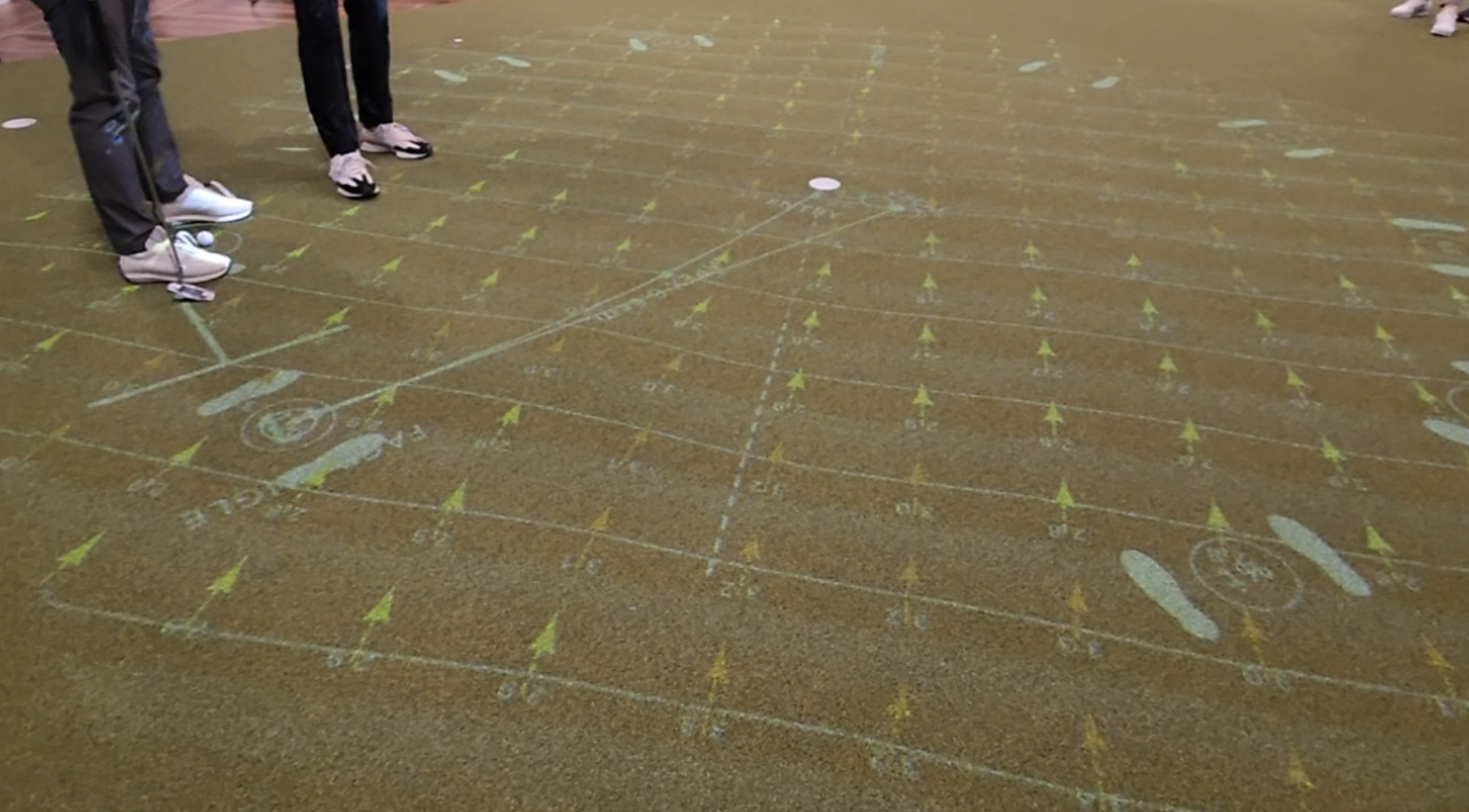
ToutPutt and its built-in sensors are capable of sensing where the lies have changed. The self-learning A.I. system actively adjusts for the changes to the putting surface, thereby eliminating the need for recalibration.
In Korea, the art of putting has found its poster child in Choi, with more and more golf academies and private studios installing TourPutt for its members. Several local tour pros and top amateurs have also installed the not-so-cheap system in their homes and have said to benefit from the move. Remember when Tiger showed up one day at the range with his own Trackman? I would imagine having a TourPutt in your basement is something like that, but I can only guess. I don’t have a personal Trackman either.
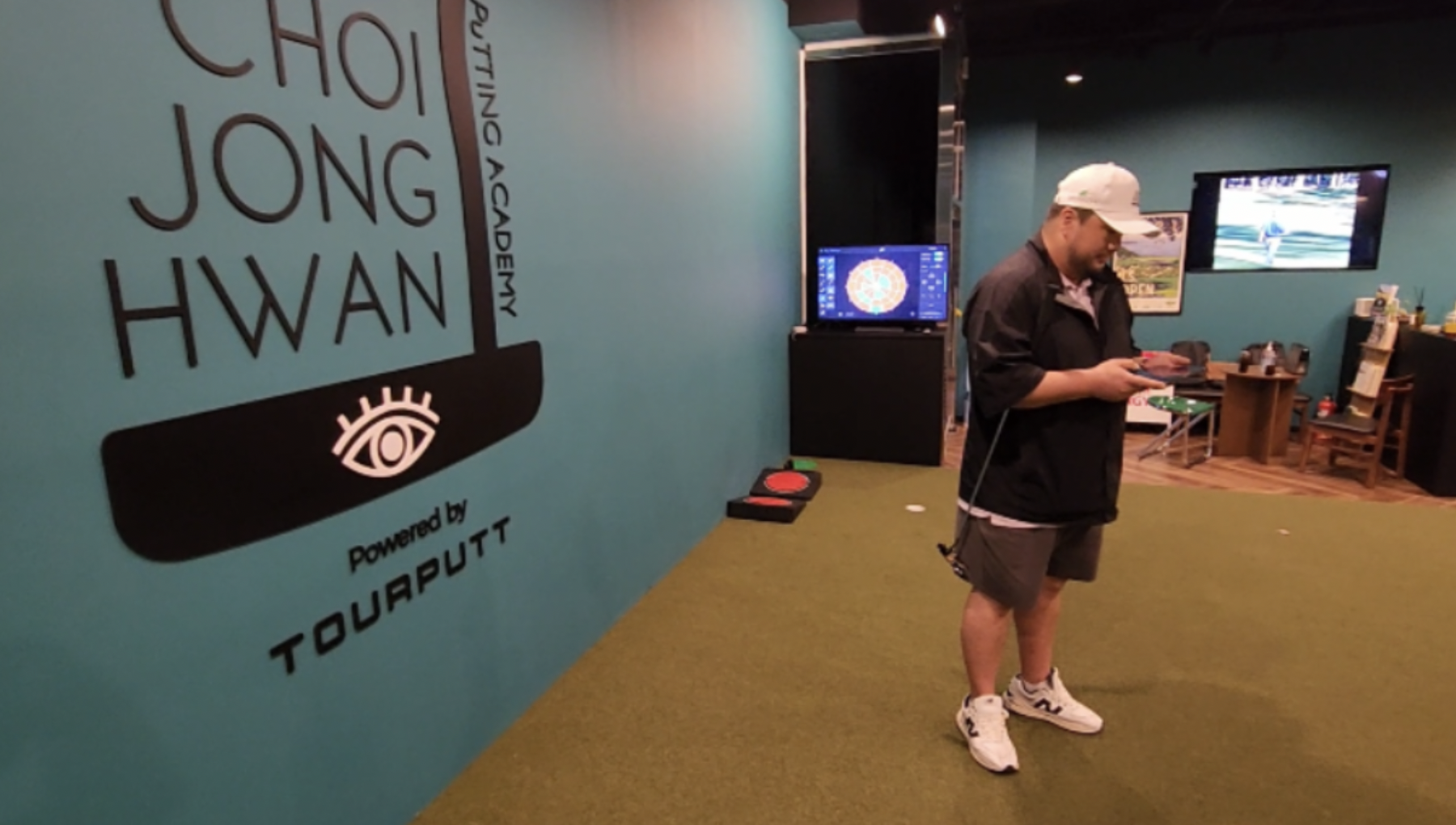
Choi attends seminars all over the world each year to continue his improvement in putting instruction.He is currently working on compiling his own training and certification program to impart to a new generation of would-be putting gurus.
Now that I know where I need to improve on, does this mean I will be taking money off my foursome buddies with alarming regularity? Well, let me see. I signed up for pilates a few months ago and found out exactly where I need to work on for more flexibility. But as I still creak all over when bending over to tie my shoes, I’d guess my putting won’t miraculously improve right away neither. But hey, that’s on me. I’ll just have to start working on the tapping part. Anyone looking to buy some used putters?
For more information on TourPutt from the man himself, check out the video below.
- LIKE116
- LEGIT7
- WOW14
- LOL0
- IDHT1
- FLOP1
- OB0
- SHANK7
19th Hole
Vincenzi’s 2024 Zurich Classic of New Orleans betting preview

The PGA TOUR heads to New Orleans to play the 2023 Zurich Classic of New Orleans. In a welcome change from the usual stroke play, the Zurich Classic is a team event. On Thursday and Saturday, the teams play best ball, and on Friday and Sunday the teams play alternate shot.
TPC Louisiana is a par 72 that measures 7,425 yards. The course features some short par 4s and plenty of water and bunkers, which makes for a lot of exciting risk/reward scenarios for competitors. Pete Dye designed the course in 2004 specifically for the Zurich Classic, although the event didn’t make its debut until 2007 because of Hurricane Katrina.
Coming off of the Masters and a signature event in consecutive weeks, the field this week is a step down, and understandably so. Many of the world’s top players will be using this time to rest after a busy stretch.
However, there are some interesting teams this season with some stars making surprise appearances in the team event. Some notable teams include Patrick Cantlay and Xander Schauffele, Rory McIlroy and Shane Lowry, Collin Morikawa and Kurt Kitayama, Will Zalatoris and Sahith Theegala as well as a few Canadian teams, Nick Taylor and Adam Hadwin and Taylor Pendrith and Corey Conners.
Past Winners at TPC Louisiana
- 2023: Riley/Hardy (-30)
- 2022: Cantlay/Schauffele (-29)
- 2021: Leishman/Smith (-20)
- 2019: Palmer/Rahm (-26)
- 2018: Horschel/Piercy (-22)
- 2017: Blixt/Smith (-27)
2024 Zurich Classic of New Orleans Picks
Tom Hoge/Maverick McNealy +2500 (DraftKings)
Tom Hoge is coming off of a solid T18 finish at the RBC Heritage and finished T13 at last year’s Zurich Classic alongside Harris English.
This season, Hoge is having one of his best years on Tour in terms of Strokes Gained: Approach. In his last 24 rounds, the only player to top him on the category is Scottie Scheffler. Hoge has been solid on Pete Dye designs, ranking 28th in the field over his past 36 rounds.
McNealy is also having a solid season. He’s finished T6 at the Waste Management Phoenix Open and T9 at the PLAYERS Championship. He recently started working with world renowned swing coach, Butch Harmon, and its seemingly paid dividends in 2024.
Keith Mitchell/Joel Dahmen +4000 (DraftKings)
Keith Mitchell is having a fantastic season, finishing in the top-20 of five of his past seven starts on Tour. Most recently, Mitchell finished T14 at the Valero Texas Open and gained a whopping 6.0 strokes off the tee. He finished 6th at last year’s Zurich Classic.
Joel Dahmen is having a resurgent year and has been dialed in with his irons. He also has a T11 finish at the PLAYERS Championship at TPC Sawgrass which is another Pete Dye track. With Mitchell’s length and Dahmen’s ability to put it close with his short irons, the Mitchell/Dahmen combination will be dangerous this week.
Taylor Moore/Matt NeSmith +6500 (DraftKings)
Taylor Moore has quickly developed into one of the more consistent players on Tour. He’s finished in the top-20 in three of his past four starts, including a very impressive showing at The Masters, finishing T20. He’s also finished T4 at this event in consecutive seasons alongside Matt NeSmith.
NeSmith isn’t having a great 2024, but has seemed to elevate his game in this format. He finished T26 at Pete Dye’s TPC Sawgrass, which gives the 30-year-old something to build off of. NeSmith is also a great putter on Bermudagrass, which could help elevate Moore’s ball striking prowess.
- LIKE6
- LEGIT1
- WOW1
- LOL0
- IDHT0
- FLOP2
- OB1
- SHANK1
19th Hole
Vincenzi’s 2024 LIV Adelaide betting preview: Cam Smith ready for big week down under

After having four of the top twelve players on the leaderboard at The Masters, LIV Golf is set for their fifth event of the season: LIV Adelaide.
For both LIV fans and golf fans in Australia, LIV Adelaide is one of the most anticipated events of the year. With 35,000 people expected to attend each day of the tournament, the Grange Golf Club will be crawling with fans who are passionate about the sport of golf. The 12th hole, better known as “the watering hole”, is sure to have the rowdiest of the fans cheering after a long day of drinking some Leishman Lager.
The Grange Golf Club is a par-72 that measures 6,946 yards. The course features minimal resistance, as golfers went extremely low last season. In 2023, Talor Gooch shot consecutive rounds of 62 on Thursday and Friday, giving himself a gigantic cushion heading into championship Sunday. Things got tight for a while, but in the end, the Oklahoma State product was able to hold off The Crushers’ Anirban Lahiri for a three-shot victory.
The Four Aces won the team competition with the Range Goats finishing second.
*All Images Courtesy of LIV Golf*
Past Winners at LIV Adelaide
- 2023: Talor Gooch (-19)
Stat Leaders Through LIV Miami
Green in Regulation
- Richard Bland
- Jon Rahm
- Paul Casey
Fairways Hit
- Abraham Ancer
- Graeme McDowell
- Henrik Stenson
Driving Distance
- Bryson DeChambeau
- Joaquin Niemann
- Dean Burmester
Putting
- Cameron Smith
- Louis Oosthuizen
- Matt Jones
2024 LIV Adelaide Picks
Cameron Smith +1400 (DraftKings)
When I pulled up the odds for LIV Adelaide, I was more than a little surprised to see multiple golfers listed ahead of Cameron Smith on the betting board. A few starts ago, Cam finished runner-up at LIV Hong Kong, which is a golf course that absolutely suits his eye. Augusta National in another course that Smith could roll out of bed and finish in the top-ten at, and he did so two weeks ago at The Masters, finishing T6.
At Augusta, he gained strokes on the field on approach, off the tee (slightly), and of course, around the green and putting. Smith able to get in the mix at a major championship despite coming into the week feeling under the weather tells me that his game is once again rounding into form.
The Grange Golf Club is another course that undoubtedly suits the Australian. Smith is obviously incredibly comfortable playing in front of the Aussie faithful and has won three Australian PGA Championship’s. The course is very short and will allow Smith to play conservative off the tee, mitigating his most glaring weakness. With birdies available all over the golf course, there’s a chance the event turns into a putting contest, and there’s no one on the planet I’d rather have in one of those than Cam Smith.

Louis Oosthuizen +2200 (DraftKings)
Louis Oosthuizen has simply been one of the best players on LIV in the 2024 seas0n. The South African has finished in the top-10 on the LIV leaderboard in three of his five starts, with his best coming in Jeddah, where he finished T2. Perhaps more impressively, Oosthuizen finished T7 at LIV Miami, which took place at Doral’s “Blue Monster”, an absolutely massive golf course. Given that Louis is on the shorter side in terms of distance off the tee, his ability to play well in Miami shows how dialed he is with the irons this season.
In addition to the LIV finishes, Oosthuizen won back-to-back starts on the DP World Tour in December at the Alfred Dunhill Championship and the Mauritus Open. He also finished runner-up at the end of February in the International Series Oman. The 41-year-old has been one of the most consistent performers of 2024, regardless of tour.
For the season, Louis ranks 4th on LIV in birdies made, T9 in fairways hit and first in putting. He ranks 32nd in driving distance, but that won’t be an issue at this short course. Last season, he finished T11 at the event, but was in decent position going into the final round but fell back after shooting 70 while the rest of the field went low. This season, Oosthuizen comes into the event in peak form, and the course should be a perfect fit for his smooth swing and hot putter this week.

- LIKE10
- LEGIT2
- WOW0
- LOL0
- IDHT0
- FLOP0
- OB0
- SHANK0
Opinion & Analysis
The Wedge Guy: What really makes a wedge work? Part 1

Of all the clubs in our bags, wedges are almost always the simplest in construction and, therefore, the easiest to analyze what might make one work differently from another if you know what to look for.
Wedges are a lot less mysterious than drivers, of course, as the major brands are working with a lot of “pixie dust” inside these modern marvels. That’s carrying over more to irons now, with so many new models featuring internal multi-material technologies, and almost all of them having a “badge” or insert in the back to allow more complex graphics while hiding the actual distribution of mass.
But when it comes to wedges, most on the market today are still single pieces of molded steel, either cast or forged into that shape. So, if you look closely at where the mass is distributed, it’s pretty clear how that wedge is going to perform.
To start, because of their wider soles, the majority of the mass of almost any wedge is along the bottom third of the clubhead. So, the best wedge shots are always those hit between the 2nd and 5th grooves so that more mass is directly behind that impact. Elite tour professionals practice incessantly to learn to do that consistently, wearing out a spot about the size of a penny right there. If impact moves higher than that, the face is dramatically thinner, so smash factor is compromised significantly, which reduces the overall distance the ball will fly.
Every one of us, tour players included, knows that maddening shot that we feel a bit high on the face and it doesn’t go anywhere, it’s not your fault.
If your wedges show a wear pattern the size of a silver dollar, and centered above the 3rd or 4th groove, you are not getting anywhere near the same performance from shot to shot. Robot testing proves impact even two to three grooves higher in the face can cause distance loss of up to 35 to 55 feet with modern ‘tour design’ wedges.
In addition, as impact moves above the center of mass, the golf club principle of gear effect causes the ball to fly higher with less spin. Think of modern drivers for a minute. The “holy grail” of driving is high launch and low spin, and the driver engineers are pulling out all stops to get the mass as low in the clubhead as possible to optimize this combination.
Where is all the mass in your wedges? Low. So, disregarding the higher lofts, wedges “want” to launch the ball high with low spin – exactly the opposite of what good wedge play requires penetrating ball flight with high spin.
While almost all major brand wedges have begun putting a tiny bit more thickness in the top portion of the clubhead, conventional and modern ‘tour design’ wedges perform pretty much like they always have. Elite players learn to hit those crisp, spinny penetrating wedge shots by spending lots of practice time learning to consistently make contact low in the face.
So, what about grooves and face texture?
Grooves on any club can only do so much, and no one has any material advantage here. The USGA tightly defines what we manufacturers can do with grooves and face texture, and modern manufacturing techniques allow all of us to push those limits ever closer. And we all do. End of story.
Then there’s the topic of bounce and grinds, the most complex and confusing part of the wedge formula. Many top brands offer a complex array of sole configurations, all of them admittedly specialized to a particular kind of lie or turf conditions, and/or a particular divot pattern.
But if you don’t play the same turf all the time, and make the same size divot on every swing, how would you ever figure this out?
The only way is to take any wedge you are considering and play it a few rounds, hitting all the shots you face and observing the results. There’s simply no other way.
So, hopefully this will inspire a lively conversation in our comments section, and I’ll chime in to answer any questions you might have.
And next week, I’ll dive into the rest of the wedge formula. Yes, shafts, grips and specifications are essential, too.
- LIKE31
- LEGIT7
- WOW1
- LOL1
- IDHT2
- FLOP3
- OB1
- SHANK3
-

 19th Hole2 weeks ago
19th Hole2 weeks agoDave Portnoy places monstrous outright bet for the 2024 Masters
-

 19th Hole2 weeks ago
19th Hole2 weeks agoTiger Woods arrives at 2024 Masters equipped with a putter that may surprise you
-

 19th Hole15 hours ago
19th Hole15 hours ago‘Absolutely crazy’ – Major champ lays into Patrick Cantlay over his decision on final hole of RBC Heritage
-

 19th Hole3 weeks ago
19th Hole3 weeks agoReport: Tiger Woods has ‘eliminated sex’ in preparation for the 2024 Masters
-

 19th Hole1 week ago
19th Hole1 week agoTwo star names reportedly blanked Jon Rahm all week at the Masters
-

 19th Hole7 days ago
19th Hole7 days agoReport: LIV Golf identifies latest star name they hope to sign to breakaway tour
-

 19th Hole1 week ago
19th Hole1 week agoNeal Shipley presser ends in awkward fashion after reporter claims Tiger handed him note on 8th fairway
-

 19th Hole6 days ago
19th Hole6 days agoBrandel Chamblee has ‘no doubt’ who started the McIlroy/LIV rumor and why















Pingback: VRotein: 2023 PGA Show, booth #2025 – UNB
Just Normal
Dec 1, 2022 at 1:20 am
This is very nice advertising for this Korean Puttview
Andrew J
Nov 23, 2022 at 1:10 pm
Why not get something that helps on real golf coursea. That wouuld be on ebay, search P&SI-EGOS for confidence over a putt like you have never had before.
Jeff
Nov 23, 2022 at 12:50 pm
Any idea what the cost is for this system?
Steve
Nov 23, 2022 at 11:08 am
In he article you state
“When I asked why it was fixed at 3%, Kim explained that tour regulation greens don’t allow for more than a 3 degree slope within 6ft of the hole”.
Degrees and slope are not equal and are different standards for measuring slope. You conflate the two here and it is confusing as the amount of slope cannot be the same as measured in degrees and percent.
Jonghwan choi
Nov 28, 2022 at 6:35 pm
Hi, i’m putting coach Jonghwan choi “%” is correct! Kim miss typing or miss understood or many people confuse that. Not 3 DEGREE! 3%!
Thank you!
Benny
Nov 23, 2022 at 6:56 am
Love it. Great article. I believe I saw Tiger with something similar at his house in a video years back.
But his green shifted and adjust which was nuts.
But then again who wouldn’t want 300y minty drives every time?